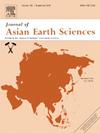Petrogenesis of early carboniferous and early Permian mafic intrusions in the Nanpanjiang Basin, SW China: Implications for northward subduction of the East Paleo-Tethys Ocean and back-arc basin formation
IF 2.7
3区 地球科学
Q2 GEOSCIENCES, MULTIDISCIPLINARY
引用次数: 0
Abstract
The Nanpanjiang Basin (NPJB) is situated along the margins of the South China block (SCB) and the Indochina block (ICB). Its position is significant for evaluating the amalgamation histories of the two blocks, which shaped present-day Southeast Asia. However, the geological community has yet to reach a consensus on the formation and evolutionary history of the NPJB. Two competing models, which include the back-arc and foreland basins, have been proposed so far. This work employs apatite U-Pb dating and oxygen isotopes, whole-rock element and Sr-Nd isotope analyses on the Funing-Napo mafic intrusions (FNMI) in the Chinese Guangxi to evaluate the magmatic and tectonic aspects of the NPJB. The studied mafic intrusions are divisible into two groups based on their apatite ages: the Early Carboniferous (349–347 Ma, Group 1) and the Early Permian (295–284 Ma, Group 2). Group 1 samples display low SiO2 (46.5–51.1 wt%) and high MgO (6.01–9.47 wt%). Group 2 samples show lower SiO2 (44.5–49.2 wt%) and more variable MgO (3.39–13.7 wt%). Geochemical modeling based on the trace elements and isotopic compositions demonstrates that the FNMI were derived from an asthenosphere mantle source with OIB-like geochemical characteristics, metasomatized by melts originating from subducted sediments. The northward subduction of the East Paleo-Tethys Ocean (EPTO) beneath the SCB likely caused the onset of a back-arc extensional tectonic regime since the Early Carboniferous. The NPJB developed as a back-arc basin and facilitated a series of mafic magmatism in the Funing-Napo and surrounding areas during the Early Carboniferous and Early Permian.

求助全文
约1分钟内获得全文
求助全文
来源期刊

Journal of Asian Earth Sciences
地学-地球科学综合
CiteScore
5.90
自引率
10.00%
发文量
324
审稿时长
71 days
期刊介绍:
Journal of Asian Earth Sciences has an open access mirror journal Journal of Asian Earth Sciences: X, sharing the same aims and scope, editorial team, submission system and rigorous peer review.
The Journal of Asian Earth Sciences is an international interdisciplinary journal devoted to all aspects of research related to the solid Earth Sciences of Asia. The Journal publishes high quality, peer-reviewed scientific papers on the regional geology, tectonics, geochemistry and geophysics of Asia. It will be devoted primarily to research papers but short communications relating to new developments of broad interest, reviews and book reviews will also be included. Papers must have international appeal and should present work of more than local significance.
The scope includes deep processes of the Asian continent and its adjacent oceans; seismology and earthquakes; orogeny, magmatism, metamorphism and volcanism; growth, deformation and destruction of the Asian crust; crust-mantle interaction; evolution of life (early life, biostratigraphy, biogeography and mass-extinction); fluids, fluxes and reservoirs of mineral and energy resources; surface processes (weathering, erosion, transport and deposition of sediments) and resulting geomorphology; and the response of the Earth to global climate change as viewed within the Asian continent and surrounding oceans.
 求助内容:
求助内容: 应助结果提醒方式:
应助结果提醒方式:


